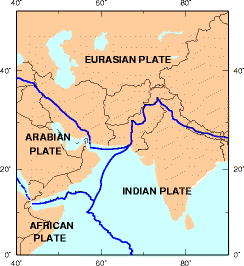Indian subcontinent: Difference between revisions
rv removal of references sans explanation |
Bharatveer (talk | contribs) rv to previous version : reason "spurious" political website |
||
| Line 7: | Line 7: | ||
The Indian subcontinent includes: |
The Indian subcontinent includes: |
||
*[[India]] |
*[[India]] |
||
*[[Pakistan]] |
|||
*[[Pakistan]] (excluding [[Balochistan (Pakistan)|Balochistan]] region<ref>[http://www.unpo.org/member_profile.php?id=66 UNPO article on Balochistan]</ref>) |
|||
*[[Bangladesh]] |
*[[Bangladesh]] |
||
*[[Bhutan]] |
*[[Bhutan]] |
||
| Line 47: | Line 47: | ||
*[[Plate tectonics]] |
*[[Plate tectonics]] |
||
*[[Continental drift]] |
*[[Continental drift]] |
||
==Reference== |
|||
<references/> |
|||
== External links == |
== External links == |
||
Revision as of 05:09, 6 November 2006


- This article deals with the geophysical region in Asia. For geopolitical treatments, see South Asia.
The Indian subcontinent is a peninsular landmass of the Asian continent occupying the Indian Plate and extending into the Indian Ocean, bordered on the north by the Eurasian Plate. The region is known as a subcontinent because its geography and geology are distinct from the rest of the continent.
The Indian subcontinent includes:
Geographically, the Indian subcontinent can be divided into the following regions:
Nomenclature and usage
The term Indian subcontinent includes only those regions which geophysically lie on the Indian Plate. Geopolitically, however, regions with cardinal directions – South Asia or Southern Asia – aptly include territories found external to the Indian Plate and in proximity to it. Myanmar (formerly Burma), for instance, is sometimes grouped in the region due to the fact that it was a part of British India for nearly a century and has historical and cultural ties to India. The subcontinent is surrounded by three water bodies: the Bay of Bengal, the Indian Ocean and the Arabian Sea.
Historically, the Indian subcontinent was known as Hindustan (Persian: The land of the Hindus) in medieval times. The region came to be known as British India or simply India, during the British Raj which lasted for more than two centuries.
Until the end of the 19th century, the Indian subcontinent along with Southeastern Asia was collectively known as the East Indies by European colonists and traders. The Indian subcontinent was referred to as Hither India (India Citerior) while Southeastern Asia was known as Further India (India Ulterior). These terms, however, are no longer in common usage with the exception of East Indies, which is mostly confined to historians and geographers (compare with West Indies).
Geography
Geographically, the Indian subcontinent is a peninsular region south of the Himalayas and Karakoram mountain ranges and east of the Hindu Kush mountain range and Balochistan region, extending southward into the Indian Ocean between the Arabian Sea (to the southwest) and the Bay of Bengal (to the southeast). It covers about 4,480,000 km² (1,729,738 mi²) or 10 percent of the Asian continent; however, it accounts for about 40 percent of Asia's population.

Geologically, most of this region is a subcontinent: it rests on a tectonic plate of its own, the Indian Plate (the northerly portion of the Indo-Australian Plate) separate from the rest of Eurasia, and was once a small continent before colliding with the Eurasian Plate and giving birth to the Himalayan range and the Tibetan plateau. Forming Carita on its northeastern frontier, even now the Indian Plate continues to move northward with the result that the Himalayas are growing taller by a few centimetres each decade. On its western frontier, the Indian Plate forms a conservative boundary with the Eurasian Plate. In addition, it is also home to an astounding variety of geographical features, such as glaciers, rainforests, valleys, deserts, and grasslands that are typical of much larger continents, in an area about half the size of the United States.
Climate
The climate of South Asia is called the Monsoon climate. It is quite opposite of the Mediterranean climate. For the monsoon climate, the weather in this region remains humid during summer and dry during winter. Instead of four seasons, it basically has two main seasons, the wet and dry. The monsoon climate favours the cultivation of jute, tea, rice, and various vegetables in this region.
See also
- South Asia
- History of South Asia
- Indology
- Etymology of India
- India (disambiguation)
- Plate tectonics
- Continental drift
